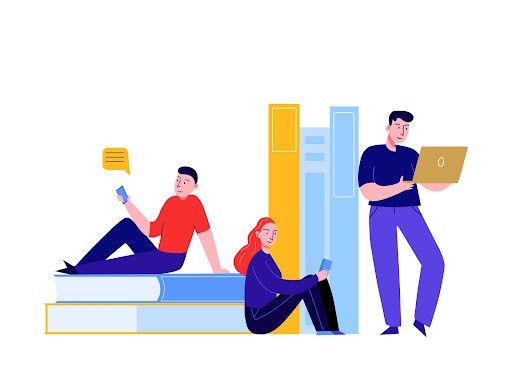
Your Guide to the Fixed Layout eBook Conversion
Summarize with:
Introduction
Since time immemorial, books have been our best friends. In fact, when there were limited options for entertainment, the world of books provided an escape to a fantasy land.
The times have changed, and the format may have changed too, but books remain one of the most-loved possessions for many. The only difference is that now people prefer to read eBooks on gadgets that allow them to read on the go. Whether you are a publisher or writer, you cannot escape from eBooks. They have become a popular book format, and ignoring them means losing out on significant opportunities.
Similar to printed books, the success of your eBook also depends upon the quality you offer to your readers. An eBook has to have a consistent layout and good readability to be able to be clicked on by your audience. You can achieve this by using either a reflowable or fixed layout.
Table of Contents:
- Why Convert Books to eBooks?
- Why Do You Need Fixed-Layout eBook Conversion?
- What is the Ideal Page Size for Fixed-Layout eBook Conversion?
- Top Advantages of Fixed Layout ePub Conversion
- The Fixed Layout eBook Conversion Process
- Conclusion
Why Convert Books to eBooks?
Since the world went digital, the way we consume information has changed drastically. The number of eBook consumers is expected to reach 1.1 billion by 2027. This consumer behavior change has compelled publishers to adapt to the creation and presentation of books.
eBooks have become popular with the masses because they do not require any physical storage space. They are easier to carry. Moreover, ePublihsing solutions result in the reduced use of paper. It is thus a sustainable practice that helps save the environment.
Also Read: How Do Publishers Benefit from Fixed-Layout ePUB Conversion?
Why Do You Need Fixed-Layout eBook Conversion?
Converting your print book into an eBook sounds simple, right? You can approach any eBook production company or do it in-house. However, you may want to note that the book’s readability may be compromised in the process.
Readers do not enjoy it when they have to adjust font style, font size, margins, etc. It takes away the joy they get from reading.
Fixed layout conversion services take care of this for you. Some platforms offer additional features like read-aloud, glossary pop-up, search functionality, text highlight, page zoom, and audio/video integration.
They offer customized services to accommodate the specific requirements of publishers or clients for fixed-layout eBook conversion. They also follow IDPF standard guidelines to enable you to upload and distribute your content. All of these can drastically enrich the readers’ experience.
Also Read: 7 Digital Content Conversion Technologies for Ebooks in 2023
Hurix Minibook: Immersive Learning for the WIN in Education!
What is the Ideal Page Size for Fixed-Layout eBook Conversion?
As a publisher, you may want to know the best page size when designing books to make fixed layout eBook conversion easier. Unfortunately, there is no one answer as readers use multiple devices ranging from Kindle to iPads to laptops to read eBooks.
Thus, it is vital to create files that are readable across devices of different sizes and resolutions.
The most important aspects you can consider to give your users the best experience while reading eBooks are the page aspect ratio and the page dimensions.
Top Advantages of Fixed Layout ePub Conversion
Publishers can improve their digital offerings and provide readers with a truly immersive and engaging experience with fixed-layout ePub conversion. Let us look at some of its advantages of ePublishing solutions:
- Publishers have complete control over the eBook’s layout, ensuring a consistent and visually appealing reading experience.
- Zoom-in/out options and smooth navigation make content more accessible and user-friendly.
- Consistent content quality is maintained across different devices and software.
- Embedded text and images improve accessibility for screen readers and other assistive technologies.
- The incorporation of interactive features like quizzes, games, and animations engage readers.
- Aligned text and images provide a clean and professional look.
- Annotations, footnotes, cross-references, and external links enrich the reading experience.
- JavaScript and CSS create dynamic and interactive eBooks.
The Fixed Layout eBook Conversion Process
Fixed-layout eBook conversion is the cornerstone of a seamless reading experience across various devices. Converting a print book or PDF into a fixed layout eBook involves several steps:
1. File Preparation
- The most common input formats for fixed layout eBook conversion are InDesign files and high-quality PDFs.
- Ensure that images are at a high resolution (300 DPI) to maintain quality on various devices.
- Embed all fonts used in the book to ensure consistent appearance across different devices.
- Pay attention to page size, margins, and the overall layout to optimize the eBook for different screen sizes.
2. Conversion
- Use specialized software like Adobe InDesign or dedicated eBook conversion tools to convert the input files into a fixed layout ePub format.
- Validate the converted ePub file to ensure it adheres to industry standards and is compatible with various eBook readers.
3. Testing and Refinement
- Test the eBook on different devices (e.g., tablets, smartphones, eReaders) to identify and fix any display issues.
- Make adjustments to the layout and formatting to optimize the reading experience on different screen sizes.
- Ensure the eBook is accessible to readers with disabilities by testing with assistive technologies.
Also Read: Top 5 Factors to Consider While Choosing the eBook Conversion Service Provider
Conclusion
Despite the influx of several media for information, books remain a favorite with the masses. The format may have gone digital, but they have not become redundant. The debate of fixed layout vs reflowable layout is common among publishers. A fixed-layout eBook is one of the best ways to ensure that your books reach a wider audience base.
Transform your print books into stunning fixed-layout eBooks with Hurix Digital. Their expertise in fixed layout eBook conversion formats can help you achieve an efficient digital publishing process. Get in touch today to learn more about our comprehensive suite of services tailored to your specific needs.
Summarize with:

Vice President – Content Transformation at HurixDigital, based in Chennai. With nearly 20 years in digital content, he leads large-scale transformation and accessibility initiatives. A frequent presenter (e.g., London Book Fair 2025), Gokulnath drives AI-powered publishing solutions and inclusive content strategies for global clients
 Upcoming Masterclass | Build an Army of Brand Evangelists using Training & Development | November 20th, 8:30 AM PDT | 11:30 AM EDT | 10:00 PM IST
Upcoming Masterclass | Build an Army of Brand Evangelists using Training & Development | November 20th, 8:30 AM PDT | 11:30 AM EDT | 10:00 PM IST

